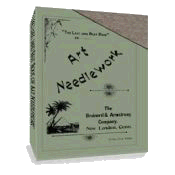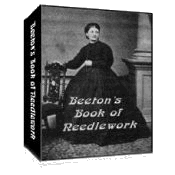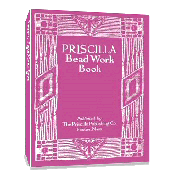Crewel Stitch Sampler
This Crewel Stitch sampler is comprised of the following stitches:
A and C, crewel stitch; B and D, outline-stitch; E, back-stitch; F, spots;
G and H, stem-stitch; J, crewel and outline-stitches in combination.

Crewel Stitch Sampler Front
Click on picture to see more detail.

Crewel Stitch Sampler Back
Click on picture to see more detail.
Stitches for Crewel Stitch Sampler
CREWEL STITCH proper is shown at A on the sampler above, where it is used for line work.
It is worked as follows: Having made a start in the usual way, keep your thread downwards under your left thumb and below your needle that is, to the right; then take up with the needle, say 1/8th of an inch of the stuff, and bring it out through the hole made in starting the stitch, taking care not to pierce the thread. This gives the first half stitch. If you proceed in the same way your next stitch will be full length. The test of good workmanship is that at the back it should look like back-stitch.
OUTLINE STITCH (B on sampler) differs from crewel-stitch only in that the thread is always kept upwards above the needle, that is to the left. In so doing the thread is apt to untwist itself, and wants constantly retwisting. The stitch is useful for single lines and for outlining solid work. The muddled effect of much crewel work is due to the confusion of this stitch with crewel-stitch proper.
THICK CREWEL STITCH (C on sampler) is only a little wider than ordinary crewel-stitch, but gives a heavier line, in higher relief. In effect it resembles rope-stitch, but it is more simply worked. You begin as in ordinary crewel-stitch, but after the first half-stitch you take up 1/8th of an inch of the material in advance of the last stitch, and bring out your needle at the point where the first half-stitch began. You proceed, always putting your needle in 1/8th of an inch in front of, and bringing it out 1/8th of an inch behind, the last stitch, so as to have always 1/4th of an inch of the stuff on your needle.
THICK OUTLINE STITCH (D on sampler) is like thick crewel-stitch with the exception that, as in ordinary outline-stitch (B), you keep your thread always above the needle to the left.
In BACK STITCH (E on sampler), instead of first bringing the needle out at the point where the embroidery is to begin, you bring it out 1/8th of an inch in advance of it. Then, putting your needle back, you take up this 1/8th together with another 1/8th in advance. For the next stitch you put your needle into the hole made by the last stitch, and so on, taking care not to split the last thread in so doing.
To work the SPOTS (F on sampler) on sampler having made a back-stitch, bring your needle out through the same hole as before, and make another backstitch above it, so that you have, in what appears to be one stitch, two thicknesses of thread ; then bring your needle out some distance in advance of the last stitch, and proceed as before. The distance between the stitches is determined by the effect you desire to produce. The thread should not be drawn too tight.
You begin STEM STITCH (G on sampler) with the usual half-stitch. Then, holding the thread downwards, instead of proceeding as in crewel-stitch (A) you slant your needle so as to bring it out a thread or two higher up than the half-stitch, but precisely above it. You next put the needle in |1/8th of an inch in advance of the last stitch, and, as before, bring it out again in a slanting direction a thread or two higher. At the back of the work the stitches lie in a slanting direction.
To work wider STEM STITCH (H on sampler). After the first two stitches, bring your needle out precisely above and in a line with them, and put it in again 1/8th of an inch in advance of the last stitch, producing a longer stroke, which gives the measure of those following. The slanting stitches at the back are only two-thirds of the length of those on the face.
CREWEL AND OUTLINE STITCHES worked (J on sampler) side by side give somewhat the effect of a braid.The importance of not confusing them, already referred to, is here apparent.
CREWEL-STITCH is worked SOLID in the heart shape in the center of the sampler. On the left side the rows of stitching follow the outline of the heart; on the right they are more upright, merely conforming a little to the shape to be filled. This is the better method.
The way to work solid crewel-stitch will be best explained by an instance. Suppose a leaf is to be worked. You begin by outlining it; if it is a wide leaf, you further work a center line where the main rib would be, and then work row within row of stitches until the space is filled. If on arriving at the point of your leaf, instead of going round the edge, you work back by the side of the first row of stitching, there results a streakiness of texture. What you get is, in effect, a combination of crewel and outline stitches, as at J, which in the other case only occurs in the center of the shape where the files of stitches meet.
To represent shading in crewel-stitch, to which it is admirably suited, it is well to work from the darkest shadows to the highest lights. And it is expedient to map out on the stuff the outline of the space to be covered by each shade of thread. There is no difficulty then in working round that shape, as above explained. In solid crewel the stitches should quite cover the ground without pressing too closely one against the other.
Return to top of Crewel Stitch Sampler page.
Return to Sampler page.
Return to Home page.



 433 pages!
433 pages!

